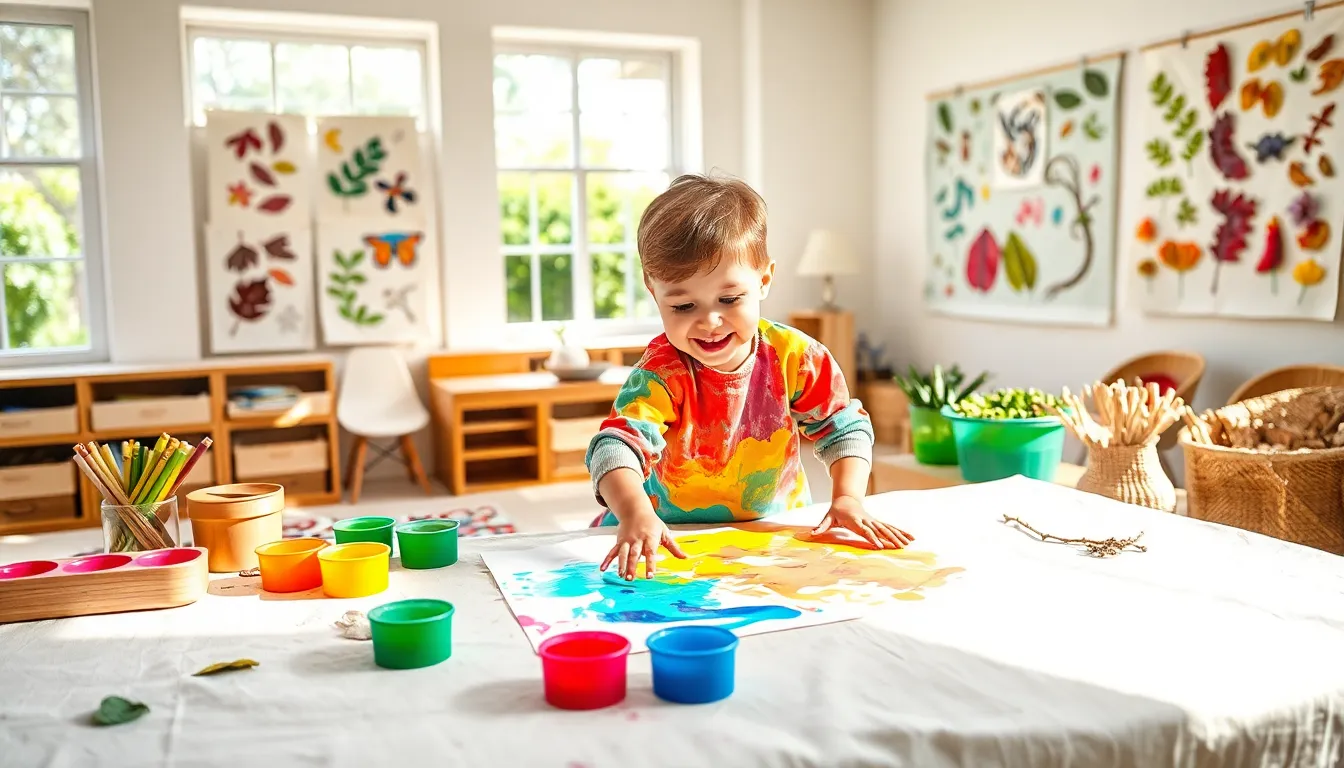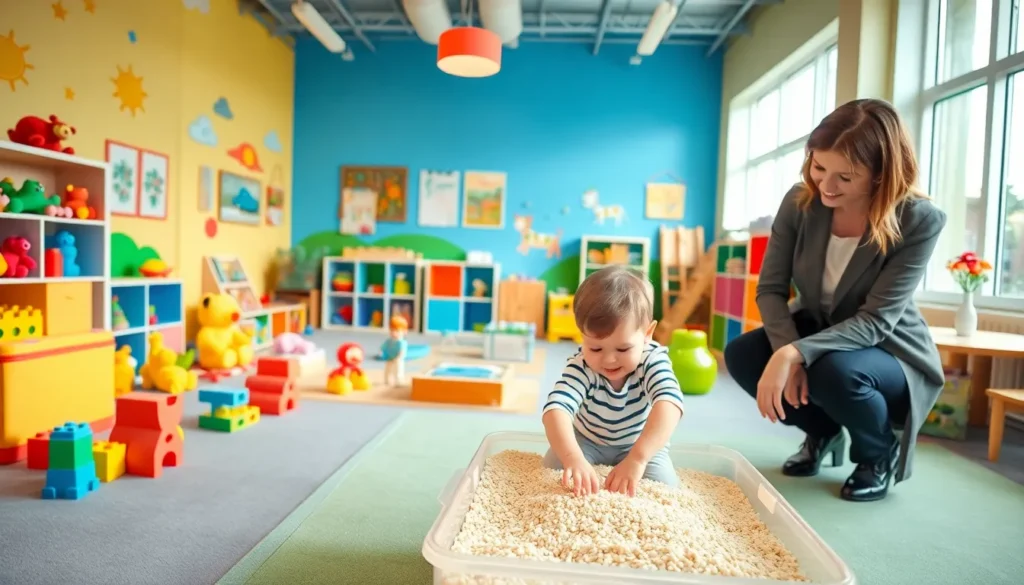Have you ever watched a toddler with a box of crayons and a blank piece of paper? It’s like handing a cat a laser pointer, pure chaos and endless fun. Process art for toddlers embraces that wild, wonderful energy, focusing on the creative journey rather than the final masterpiece. If you’re curious about how to turn those little artists loose, grab a smock and some paint: it’s time to jump into the colorful world of process art.
Table of Contents
ToggleUnderstanding Process Art

Process art is all about the experience, not the end product. It encourages toddlers to explore various materials and techniques, fostering their creativity without the pressure of producing a specific result. This approach contrasts sharply with traditional art methods, which often emphasize the final piece. The goal here is simple: let those tiny hands explore the boundaries of art. Every splatter of paint, twist of paper, and tear of clay is a testament to their imaginative journey. When it’s all about the process, you open a gateway to endless exploration.
Benefits of Process Art for Toddlers
Engaging in process art offers a plethora of benefits for toddlers. These benefits include:
- Enhancing Fine Motor Skills: As toddlers manipulate different materials, they strengthen their hand-eye coordination and develop essential motor skills that will benefit them in many areas of life.
- Fostering Creativity: With no rules governing their art, toddlers can express themselves freely. This freedom cultivates innovative thinking and problem-solving skills.
- Boosting Self-Esteem: When kids create art without the pressure of perfection, they feel accomplished and empowered, giving them a solid confidence boost.
- Encouraging Exploration: Process art allows toddlers to experiment with colors, textures, and tools, promoting a love of learning and discovery.
- Facilitating Emotional Expression: Art provides a great outlet for feelings. It helps toddlers express emotions they may not yet have the words for.
By immersing toddlers in this world of sensory experiences, they not only learn but grow in ways that serve them for years to come.
Essential Materials for Process Art
Setting up for process art doesn’t require a trip to the craft store every time. In fact, most art supplies can be sourced from around the house. Here are some essential materials:
- Crayons and Markers: Great for scribbling and drawing, these everyday items are staples in any art toolkit.
- Washable Paints: Easy to clean, these paints can transform any surface into a canvas.
- Paper of Various Textures: From plain printer paper to textured scrapbook sheets, the options are endless.
- Natural Materials: Leaves, twigs, and stones add a unique element to art projects.
- Recyclables: Empty boxes, milk jugs, and egg cartons can be repurposed into art supplies.
- Textiles: Fabrics, yarn, and ribbons offer a variety of tactile experiences.
With these materials, the possibilities for creativity are not just endless, they are practically limitless.
Creative Ideas for Process Art Activities
Looking for inspiration? Here are some engaging process art activities that will keep toddlers glued to their creative endeavors:
1. Nature Collage
Take a walk outside and collect natural materials. Once back home, encourage your toddler to arrange these pieces into a collage. This reinforces a connection with nature and helps develop both fine motor skills and visual-spatial awareness.
2. Bubble Wrap Printing
Dab some paint on bubble wrap, press paper onto it, and watch as delightful prints emerge. This activity is not just messy fun but also offers a visual surprise at the end, perfect for toddlers with a sense of wonder.
3. Sensory Painting
Create a sensory experience by adding found objects, like pasta or sand, to paint. Not only does it engage multiple senses, but it also piques curiosity about textures and materials.
4. Finger Painting
This classic activity allows toddlers to explore colors through touch. Plus, who doesn’t love the idea of diving their hands into a sea of paint?
5. Story Stones
Gather some smooth stones and let toddlers paint scenes or characters. These can then be used to spark storytelling, promoting both creativity and language development.
These activities are just launching pads for your toddler’s imagination, and who knows? You might end up getting a bit messy while joining in.
Setting Up a Process Art Space
Creating a dedicated space for process art is essential, trust me, it helps keep both the mess and the creativity contained. Here’s how to set up a wonderful art corner:
- Choose an Area: Find a spot that can handle a little chaos. An outdoor area or a space lined with newspapers works wonders.
- Provide Easy Access to Supplies: Store supplies in bins or baskets labeled clearly so toddlers can help themselves. The less friction there is in getting started, the more likely they are to create.
- Use Protective Covers: Consider a tablecloth or old sheets to cover surfaces. It makes cleanup easier and gives toddlers the freedom to explore with less worry.
- Dress for Success: Have old t-shirts or smocks ready to keep their clothes paint-free. A little humor goes a long way, no one wants to explain paint stains on a favorite shirt.
With a well-organized space, toddlers can unleash their creativity without the stress of making too big of a mess.
Encouraging Expression and Exploration
Once the stage is set, it’s time to encourage toddlers to jump into process art with enthusiasm. Here are some effective ways to support their creative endeavors:
- Praise the Process, Not the Product: Focus on their effort rather than the artwork’s outcome. This reinforces the idea that creativity is about exploration.
- Ask Open-Ended Questions: Engage them with questions like, “What do you notice about your colors?” or “How does that feel?” This promotes deeper thinking and expression.
- Create with Them: Join in. Art can be a fantastic bonding experience. Your presence not only boosts their confidence but also generates excitement.
- Share Art in Progress: Display their art at various stages, allowing them to see that every phase is beautiful and important.
By offering encouragement and engaging in their artistic journey, toddlers learn to express themselves without fear, paving the way for a lifetime of creativity.




